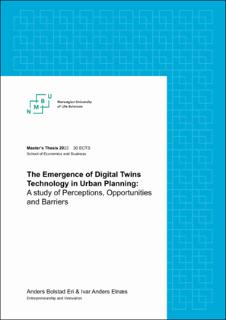| dc.description.abstract | This master’s thesis investigates the impact of digital twin technology in urban planning practice. It also investigates its potential and barriers for implementation, aiming to lay the groundwork for further innovation in urban planning.
Employing a qualitative approach, the research involved a workshop observation at Stranda municipality in a joint project between NTNU, NMBU, and Augmented City, where participants navigated a digital twin virtual world and discussed the development of the world heritage area around the Geiranger Fjord. Additionally, the study incorporated expert consultations and two separate focus group discussions with urban planners.
The findings reveal strong enthusiasm for the technology among urban planners, particularly for its visualization capabilities and potential to address context-specific urban challenges. The technology's capacity to reduce reliance on external consultants, increase dynamism in the planning process, and its predictive capabilities were also seen as significant benefits. However, successful implementation requires user-friendly design, acquisition of new expertise, strong management support, and effective collaborative strategies. The results suggest that digital twin technology holds great promise for transforming urban planning practices, but its adoption and effective use hinge on overcoming certain organizational and institutional challenges.
The study's credibility is established through the triangulation of data sources, expert input, and rigorous data analysis, while ethical considerations ensure that participants' privacy, confidentiality, and informed consent are protected throughout the research process. Although the study is based on a relatively small sample of participants, it provides valuable insights into the user implementation process of digital twin technology, contributing to the growing body of knowledge in the field of urban planning.
Overall, this master’s thesis highlights the need for further research to explore the potential benefits and challenges of implementing digital twin technology in urban planning, as well as the importance of interdisciplinary collaboration to facilitate the successful adoption of this emerging technology. | |
